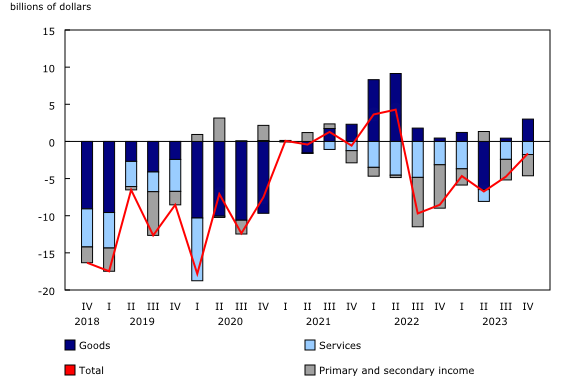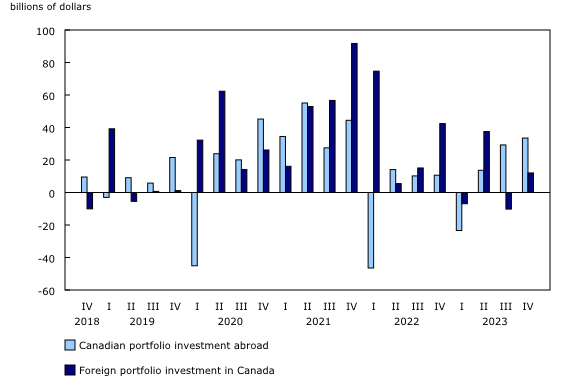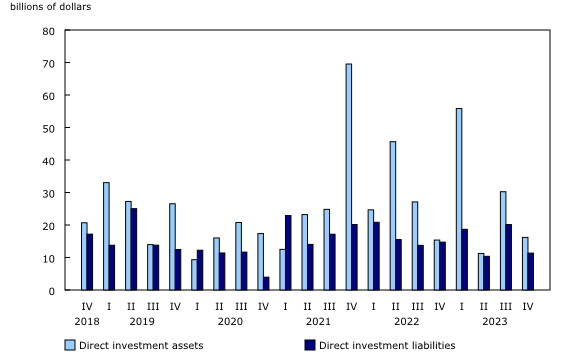Canada's balance of international payments, fourth quarter 2023
Released: 2024-02-28
-$1.6 billion
Fourth quarter 2023
Canada's current account balance (on a seasonally adjusted basis) recorded a $1.6 billion deficit in the fourth quarter, narrowing $3.1 billion from the previous quarter. The lower deficit mainly reflected a stronger goods surplus.
In the fourth quarter, in the financial account (unadjusted for seasonal variation), inflows of funds from abroad to finance the current account deficit came primarily from transactions in currency and deposits. Foreign holdings of these instruments in Canada increased considerably over the quarter. This activity was moderated by strong Canadian acquisitions of foreign securities.
For the year 2023, recalibrating supply chains, volatility in commodity prices, recovery in global stock markets, and international travel reaching new heights all had an impact on balance of payments flows.
Current account
Exports and imports of goods and services increase
The trade in goods and services balance posted a $1.2 billion surplus in the fourth quarter, a $3.2 billion change from a deficit of $2.0 billion in the third quarter. Exports and imports of both goods and services increased during the fourth quarter.
Exports of goods rose by $2.9 billion to $195.0 billion in the fourth quarter, while imports were up $0.3 billion. As a result, the trade in goods surplus widened from $0.4 billion in the third quarter to $3.0 billion in the fourth quarter. Exports of energy products led the increase in exports, as they were up by $5.3 billion, mainly on higher export volumes of crude oil. Increases in imports of consumer goods (+$1.5 billion) and basic and industrial chemical, plastic and rubber products (+$1.0 billion) were largely offset by lower imports of motor vehicles (-$1.6 billion) and metal products (-$1.1 billion).
The trade in services deficit narrowed by $0.6 billion to $1.8 billion in the fourth quarter. The travel services surplus widened by $1.0 billion, as expenses of non-residents visiting Canada rose and expenses of Canadians travelling abroad fell. At the same time, the transportation services deficit widened from $3.4 billion in the third quarter to $3.8 billion in the fourth quarter.
Investment income edges up to surplus
The investment income balance went from a slight deficit in the third quarter to a slight surplus of $112.0 million in the fourth quarter. Lower profits earned by foreign direct investors in Canada led to a higher direct investment income surplus, while interest generated on banks' intercompany deposits resulted in a net payment and moderated the overall surplus.
Financial account
Strong Canadian investment in US securities
Canadian investors acquired $33.5 billion of foreign securities in the fourth quarter. Canadian acquisitions of US securities amounted to $26.7 billion, the largest investment in two years.
Further, foreign investors increased their holdings of Canadian securities by $12.0 billion in the fourth quarter. Investors reduced their exposure to the Canadian equity market for a fourth consecutive quarter. Meanwhile, they acquired Canadian debt securities, largely federal government instruments.
As a result, portfolio investments generated a net outflow of funds from the economy of $21.5 billion in the fourth quarter.
Direct investment activity slows down
Canadian direct investment abroad slowed to $16.2 billion in the fourth quarter, down from $30.2 billion in the third quarter. While mergers and acquisitions activity ($5.9 billion) was on par with the previous two quarters, earnings reinvested by Canadian parents in their foreign affiliates accounted for the bulk of the investment in the fourth quarter. On a sector basis, the largest investment was in affiliates of the finance and insurance sector.
Foreign direct investment in Canada totalled $11.3 billion in the fourth quarter, almost back to the low level of the second quarter and following a recovery in the third quarter. Merger and acquisition transactions amounted to $5.5 billion in the fourth quarter, up from $3.6 billion in the third quarter. The manufacturing sector was the main recipient of the foreign direct investment in the fourth quarter.
Year 2023 in review
Current account deficit rises
For the year 2023, the current account balance posted a $17.8 billion deficit, up $7.4 billion compared with 2022. The increase in the deficit was largely due to the trade in goods balance going from a surplus of $19.7 billion in 2022 to a deficit of $1.8 billion in 2023.
Total exports of goods declined by $10.9 billion in 2023, as lower prices led to a decrease in exports of energy products (-$40.9 billion). Despite the decline, annual exports of energy products were the second-highest exports on record. Partially offsetting the decrease in energy products, exports of motor vehicles and parts increased $21.2 billion. Imports of goods increased by $10.6 billion, largely because of higher imports of motor vehicles and parts. The increases in both exports and imports of motor vehicles and parts occurred as the impact of supply chain issues in the automotive industry continued to lessen.
The trade in services deficit narrowed in 2023, as the transportation services deficit decreased, the commercial services balance increased, and the travel services balance went from a deficit position to a surplus. Services exports reached $200.6 billion in 2023, an increase of $27.6 billion over 2022, while services imports rose $21.1 billion to $210.0 billion. Travel services and commercial services drove export gains in 2023. The increases were attributable to the combination of increased non-residents' expenditures while travelling in Canada, international student spending, and continued growth of digital business services, which also contributed to the growth in imports of commercial services. The increase in Canadians' expenditures while travelling abroad, mainly to non-US destinations, accounted for most of the growth in services imports.
The investment income balance went from a deficit of $4.3 billion in 2022 to a surplus of $7.4 billion in 2023. Higher profits earned by Canadian direct investors abroad combined with lower profits earned by foreign direct investors in Canada contributed to the return to a surplus position.
Canadian investment abroad is on the rise
In the financial account, both direct and portfolio investment activities generated a net outflow of funds in 2023, as Canadian acquisitions abroad surpassed foreign acquisitions in Canada.
Canadian investors acquired $53.0 billion of foreign securities in 2023, following an $11.5 billion divestment in 2022. Purchases of foreign bonds, mainly government instruments, and US shares accounted for most of the activity in 2023. The investment in US shares followed a large divestment in 2022, as the US stock market rebounded significantly. Moreover, foreign investors acquired $32.4 billion of Canadian securities in 2023. Foreign investment in Canadian bonds continued but at a slower pace than in 2022, while foreign investors reduced their holdings of Canadian shares for a second consecutive year in 2023. Most major foreign stock markets outperformed the Canadian stock market in 2023.
In 2023, direct investment activity, both outward and inward, essentially was on par with 2022 levels. Direct investment abroad remained strong, at $113.5 billion in 2023. However, the composition of the investment changed, as merger and acquisition activities more than doubled to reach $58.5 billion. Close to two-thirds of the investment was directed to the United States in 2023. Meanwhile, direct investment in Canada amounted to $60.5 billion, with the bulk of the investment coming from US direct investors. The manufacturing, the trade and transportation and the management of companies and enterprises sectors were the main recipients of this investment.
Did you know we have a mobile app?
Get timely access to data right at your fingertips by downloading the StatsCAN app, available for free on the App Store and on Google Play.
Note to readers
Revisions
Following a hiatus due to the COVID-19 pandemic, data compilation from Statistics Canada's Visitor Travel Survey resumed in 2023. Given that this data source provides statistics on visitors from the United States and from overseas to Canada, including granular information on the characteristics of their travel and spending levels, upward revisions have been made to personal travel exports for the first three quarters of 2023, replacing previous estimates of travel services derived primarily from frontier counts data.
Definitions
The balance of international payments covers all economic transactions between Canadian residents and non-residents in three accounts: the current account, the capital account and the financial account.
The current account covers transactions in goods, services, compensation of employees, investment income and secondary income (current transfers).
The current account data in this release are seasonally adjusted. For information on seasonal adjustment, see Seasonally adjusted data - Frequently asked questions.
The capital account covers capital transfers and transactions in non-produced, non-financial assets.
The financial account covers transactions in financial assets and liabilities.
In principle, a net lending (+) or net borrowing (-) derived from the sum of the current and capital accounts corresponds to a net lending (+) or net borrowing (-) derived from the financial account. In practice, as data are compiled from multiple sources, this is rarely the case and gives rise to measurement error. The discrepancy (net errors and omissions) is the unobserved net inflow or outflow.
Foreign direct investment is presented on an asset-liability principle basis (that is, gross basis) in the financial account. Foreign direct investment can also be presented on a directional principle basis (that is, net basis), as shown in supplementary foreign direct investment tables 36-10-0025-01, 36-10-0026-01, 36-10-0473-01 and 36-10-0656-01. The difference between the two foreign direct investment conceptual presentations resides in the classification of reverse investment such as (1) Canadian affiliates' claims on foreign parents and (2) Canadian parents' liabilities to foreign affiliates. Under the asset-liability presentation, (1) is classified as an asset and included in direct investment assets, also referred to as direct investment abroad in this text, and (2) is classified as a liability and included in direct investment liability, also referred to as direct investment in Canada in this text.
For more information on the balance of payments, consult, "Chapter 8. International Accounts," in the User Guide: Canadian System of Macroeconomic Accounts, available on Statistics Canada's website. The chapter also presents the most recent balance of payments statistics.
Real-time table
Real-time table 36-10-0042-01 will be updated on March 11. For more information, see Real-time data tables.
Next release
Balance of international payments data for the first quarter of 2024 will be released on May 30.
Products
The document, "Enterprise surveys and the measurement of digital trade in services in Canada," which is part of Latest Developments in the Canadian Economic Accounts (13-605-X), is now available.
The product Canada's international trade and investment country fact sheet (71-607-X) is available online. This product provides easy and centralized access to Canada's international trade and investment statistics, on a country-by-country basis. It contains annual information for nearly 250 trading partners in summary form, including charts, tables and a short analysis that can also be exported in PDF format.
The product "Canada and the World Statistics Hub" (13-609-X) is available online. This product illustrates the nature and extent of Canada's economic and financial relationship with the world using interactive graphs and tables. This product provides easy access to information on trade, investment, employment and travel between Canada and a number of countries, including the United States, the United Kingdom, Mexico, China and Japan.
The Economic accounts statistics and International trade statistics portals are available from the Subjects module of the Statistics Canada website.
The product Methodology for Exports of Energy Products within the International Merchandise Trade Program, which is part of Latest Developments in the Canadian Economic Accounts (13-605-X), is available.
The Methodological Guide: Canadian System of Macroeconomic Accounts (13-607-X) is available.
The User Guide: Canadian System of Macroeconomic Accounts (13-606-G) is also available.
Contact information
For more information, or to enquire about the concepts, methods or data quality of this release, contact us (toll-free 1-800-263-1136; 514-283-8300; infostats@statcan.gc.ca) or Media Relations (statcan.mediahotline-ligneinfomedias.statcan@statcan.gc.ca).
- Date modified:



